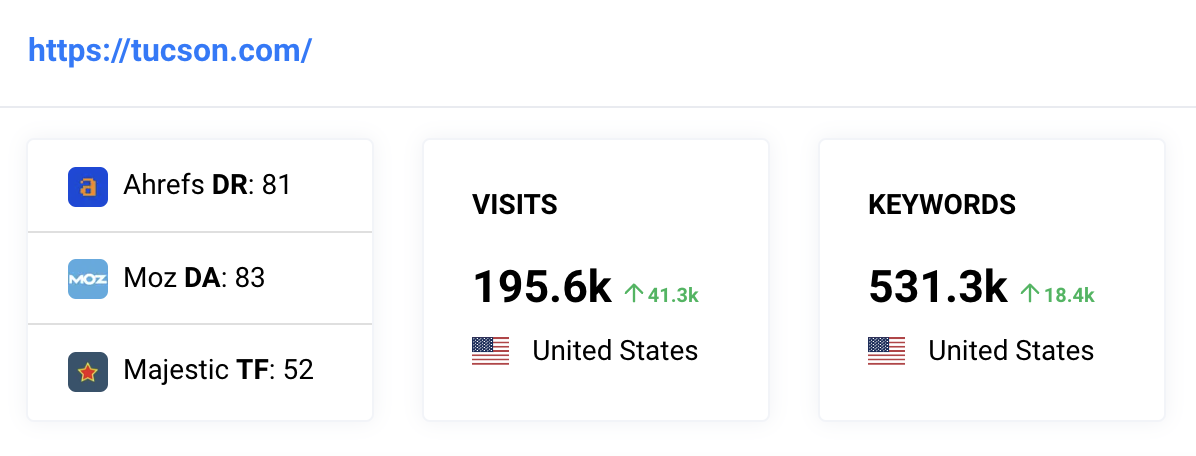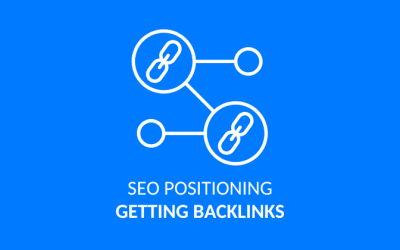Link building metrics: keys to optimize your SEO strategy

What do we mean by Linkbuilding Metrics? To those data that allow us to measure the quality of a website. We have to start from the premise that not all metrics serve the same purpose and that all websites are born at 0, (without metrics), so we are all on equal footing at birth.
Before continuing with the article we have to be honest with you, in order to measure websites, i.e. to get metrics, you need the tools that allow us to find out each little number. Unfortunately, they are quite expensive. But, but, but, but, in Linkatomic we have made the investment for you, so you can see the updated metrics, fresh and from each of the most powerful tools to measure the possible impact of a link. (You’re welcome) Just access the platform and enjoy a walk among the main statistics offered by the most powerful SEO providers in the market.
So get ready for us to help you learn about each of them and how they directly impact linkbuilding. Welcome to the quick course on metrics, everything you need to know before buying a link and nobody tells you.
Why are link building metrics important?
Before you know what the main link building metrics are, it is necessary that you are clear about their importance. Let’s start by saying that the metrics allow you:
- Evaluate the authority of a domain: through them, you can know if a site is worthy of receiving links or not. This way, you will not waste time and money on something that will not be useful for your purposes.
- Identify linking opportunities: you will more easily find sites with good authority that may be of interest for your content.
- Measure the capacity of a website: you will be able to know if the web trend is sufficient for your purpose or if you have to look for a better option.
Keep in mind that, without this data, any link building strategy would be blind, and believe me, we are the first ones who are not interested in that. Because here, we all want results.
Main link building metrics
Now, let’s see what are the most relevant link building metrics and how each of them directly affects the quality of the link you want to insert on that website. Remember that not everyone is worthy of mentioning you.

Ahrefs Domain Rating (DR)
Domain Rating (DR) is a metric developed by Ahrefs whose function is to measure the authority of a domain on a scale of 0 to 100, based on the quantity and quality of inbound links a website receives.
The higher the DR of a site, the higher the probability that it will perform better in search engines, as it indicates that the domain is reliable and has a good potential to improve your ranking. I repeat, potentially.
If you want to improve your DR of your site, focus on getting links from domains with high authority and relevance in your sector.
In other words, if I link to a DR 90 website, will I be the king of the mambo tomorrow and my DR will potentially be higher?
Let’s see, if I drink a slimming tea from Mercadona, will I be Jennifer Aniston tomorrow? I wish I were.
Let’s use logic, the DR of a website is measured mainly in the quality and quantity of inbound links. Hence, getting links is very important. But, it does not mean that they have magical powers. This is a long-distance race. So I think the best we can do is to see what advice for the DR brings us the SEO expert in the field Laura García:
Expert advice
When I am asked about the most effective linkbuilding strategy to positively affect the DR, my answer is always the same: perseverance, patience and thematic.
I know that it would be great to drink a protein shake and be “blown away“. But the fact is that consistency is the only thing that works. There are no shortcuts, only work. It is true that the links should come on their own, but in reality, who knows you except your competitors or an affiliate who wants to take advantage.
That is why it is much more effective to select where, how and in what way you are linked. My advice is: choose the best media, the most thematic and the ones that best fit your project. He who waits for the lottery, waits for the lottery. He who seeks fortune, finds it.

Laura García
SEO and Link Building Campaign ManagerMajestic Trust Flow (TF) and Citation Flow (CF)
The Trust Flow (TF) and Citation Flow (CF) metrics are two indicators developed by Majestic. The first one measures the quality of links pointing to a domain, while the second one evaluates the quantity of links it has. Both are presented on a scale of 0 to 100. Which one is better, and what good does it do me to know this?
TF is very useful in determining the trustworthiness of a site, while CF can help you understand the popularity of the site. If you want your link building strategy to be really effective, ideally both values should be high, as a high TF and a low CF could indicate that the site has quality links, but is not “very popular”.
Let me give you a practical example: If I have a friend who speaks very well of me, it means that I am a good friend. But it does not mean that I am the best friend in the world, because although the person who speaks highly of me is reliable, we can not contrast it. It would be much better if the contrasted opinion of many friends still speaks highly of me, wouldn’t it?
What about in the opposite direction, low TF and high CF? Maybe the links pointing to that site are not to be trusted… There seem to be a lot of them and of low reliability.
Although in this case I bring you a disclaimer. What happens with newspapers? They are reliable sources of information, trusted and handled by everyone, so they are linked from thousands and thousands of sites almost daily, which makes their Trust Flow go down. It is logical. And in turn, what will happen to the Citation Flow? It will be crazy high, if you have so many links… Your CF will be high and the difference will be very noticeable.
What should we take into account when choosing a medium according to its CF and TF?
Expert advice
I literally go through links all day long. I can smell the “fraudulent” websites a mile away. I think I have already said it a thousand times and the most important thing for you to be linked is that the web is thematic. Once we have this clear we move on to the metrics.
When it comes to CF and TF, a TF/CF ratio of 0.7 to 1 is generally considered healthy. And something that not everyone takes into account is in which thematic category they have TF. It’s not the same if it’s in Health as it is in real estate theme (see why I’m so insistent on the context of everything?).
On the other hand, it is a VERY manipulable metric. There are websites that have such a cycled CF that they have lost any possible credibility when looking at their micro CF. That said, look for balance and take a look at the links the site has. That can give you the information you need in the blink of an eye. It’s like checking references before you hire someone.

Laura García
SEO and Link Building Campaign ManagerMOZ Domain Authority (DA) and Page Authority (PA)
MOZ, a leading SEO company, developed the Domain Authority (DA) and Page Authority (PA) metrics in order to predict the potential of a specific domain or page to rank in search results. These metrics are also measured on a scale of 0 to 100.
We could say that DA is a (distant) cousin of DR, but if you ask my specific opinion, it’s such an easy metric to manipulate with massive links that looking at it in isolation and relying on it blindly can make you screw up.
If you only had the DA of a page at your fingertips, and you needed to know its reliability, which metric would you use for the analysis? Easy, the CF. Very high CF and high DA = great possibilities of a website on steroids.
On the contrary, if it has a high DA, and the TF – CF similar? It looks better, accompanied if possible by other metrics to ensure that it is legitimate.
Sistrix Visibility Index
The visibility index is a unique Sistrix metric that measures the visibility of your domain or any other domain in Google search results. It is calculated based on the keywords a site ranks for and their respective estimated traffic.
With the visibility index, you can see not only how many links a domain has, but also how well it is performing in terms of organic traffic. This is a powerful tool to identify opportunities to get links from sites that are already succeeding in your niche.
To improve it, dedicate yourself to work on your on-page and off-page SEO. Remember that it is very important that your site is optimized for relevant keywords.
But as always, a practical case of those who enlighten us all. A medium with DA 50 and TF 30, but if Sistrix shows 0.0, are you interested in the link? I don’t think it’s worth it. What’s more, I’m sure the site is not indexed, has no traffic and if you pull my tongue out it’s an expired domain.
Can we consider traffic and visits a metric?
The clear answer is yes.
Analyzing visits and keywords will help you identify what content is really working on other sites and, based on that, create relevant, quality content that is more likely to attract links.
To improve these metrics, the best thing you can do is to use analytics tools that allow you to identify which keywords are performing well and focus your efforts on creating content that uses them.
There are many good tools, such as Seranking or SemRush that allow us to estimate these two metrics.
SEMRUSH reference domains
Finally, the SEMRUSH online tools platform provides information on referring domains, which are nothing more than sites that are linking to your domain or one you are considering. This metric is crucial for understanding a site’s link profile and identifying opportunities for quality links.
A high number of referring domains suggests that the site has a good link building strategy.
If your goal is to increase this number you will have to diversify your sources of backlinks. You could also consider doing some collaborations or writing an article on someone else’s blog, among other practices.
In addition, through its AS tool, also known as “SEO Audit” or “Site Audit“, you can analyze the SEO health of a website based on several key factors. This helps you identify technical issues that may be affecting your site’s performance in search engines, such as broken links, 404 errors, redirect problems, duplicate content, and others.
AS also allows you to perform periodic audits to monitor the health of your site, obtain detailed reports and make comparisons between the SEO health of your site and that of your competitors, helping to identify possible areas for improvement.
Why is it necessary to monitor metrics?
Perhaps at this point you are still wondering what sense it makes for you to keep track of each and every one of the metrics mentioned above. To clear up any remaining doubts, let me explain that all of them will allow you to have a clear view of the health of your link profile. That is, they will help you to:
- Evaluate the quality of links: keep in mind that not all links are equal. But metrics allow you to identify high quality links that really add value to your site.
- Identify opportunities for improvement: by monitoring your performance and that of your competitors, you can identify areas of opportunity to improve your link building strategy.
- Measure the impact of your actions: when you evaluate how these metrics change over time, you can determine which tactics have worked well and which need to be adjusted.

Get 10% extra credit for your Link Building
Use the coupon WELCOME10 on your first recharge and get powerful links in newspapers and blogs of your topic. We have +20.000 digital media.
How to integrate metrics into your link building strategy
Now that you know what the most relevant link building metrics are, you should learn how to integrate them into your strategy. Here are some key steps that can be very helpful:
- Competitor analysis: use tools such as Ahrefs and SEMRUSH to analyze the link profile of your competitors. Look at their RD, DA and referring domains to identify opportunities.
- Site selection: Confirm that the sites you want to link to have high scores on metrics such as TF, CF, DA and PA. This will ensure that your links will have a positive impact on your rankings.
- Diversify your link sources: It’s also important that you don’t limit yourself to one type of link. Combine links from blogs, media, directories and social networks to create a more robust link profile. And check first the metrics of each of them as we indicated in the previous point.
- Creating quality content: use visitor and keyword metrics to create content that attracts both traffic and links. Don’t forget that valuable content is much more likely to be shared and linked to. Therefore, try to make your content solve problems or answer questions from your audience.
- Continuous monitoring: get used to periodically review the metrics of your domain and your competitors’ domains. By doing this you will be able to adjust your link building strategy and stay updated on market trends.

As you have seen, link building metrics play a key role in your SEO strategy, as they allow you to evaluate the performance of your website or any other, and provide you with a clear roadmap to improve your online authority and visibility.
So don’t underestimate them. Learn how to use them properly and they will become the key to achieve greater success in your SEO efforts. At Linkatomic we can help you with that, since in our platform you will find all these metrics available for all the websites, blogs and newspapers in different languages and countries we work with.
Make the most of this data and transform your strategy into a sure path to growth and digital visibility.
Link building metrics you absolutely must know about
Do you need help with your SEO and branded content strategy?
In Linkatomic we offer you 20.000 newspapers and blogs to improve your visibility on the internet.


